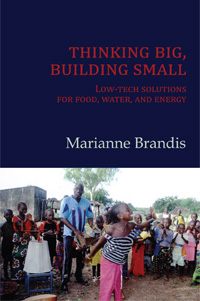Jock Brandis works for peanuts, or more accurately, for peanut shellers. His hand-cranked invention, the Universal Nut Sheller, enables farmers to shell nuts 60 times faster than they can by hand. In Thinking Big, Building Small, Jock’s sister Marianne – a Stratford, Ontario-based writer – tells the story of the nut sheller and other similar inventions that he’s produced as part of an NGO called the Full Belly Project.
Jock Brandis works for peanuts, or more accurately, for peanut shellers. His hand-cranked invention, the Universal Nut Sheller, enables farmers to shell nuts 60 times faster than they can by hand. In Thinking Big, Building Small, Jock’s sister Marianne – a Stratford, Ontario-based writer – tells the story of the nut sheller and other similar inventions that he’s produced as part of an NGO called the Full Belly Project. Jock founded the organization with a group of former Peace Corps volunteers, which eventually grew “to support the improvement of economic possibilities for people in global communities.”
When Jock was visiting Mali in 2000, a local woman made a request of him: find and send a “small machine for shelling peanuts, something that wouldn’t need electricity (which the villagers didn’t have) or gasoline (which they couldn’t afford).” Back home in North Carolina, Jock discovered that such a sheller didn’t exist. So he invented it.
The Universal Nut Sheller provided a crash course in small-scale, low-cost, environmentally friendly machinery that makes the most of available and renewable resources. Other inventions quickly began to crowd Jock’s workshop: a pedal-powered sheller; a portable “mini-factory” that shells, winnows and extracts oil in one handy unit; a gravity-powered water pump for irrigating crops; an ultraviolet scanner for detecting fungus-contaminated nuts; and a low-water hand-washing station made with half a rubber tire and plastic soft-drink bottles.
Three years later, the Full Belly Project was born. Since drought doesn’t respect geopolitical boundaries, Jock’s tinkering talents were as applicable in the arid African Sahel as they were to small farmers in humid North Carolina, where his technological contributions include a mobile solar-powered water pump.
In addition to joining her brother in the field, Marianne Brandis took advantage of unrestricted access to his emails, field reports and even his collaborators. With these resources, she maps the Full Belly Project’s bumpy road to success, complete with detours, dead ends and close calls. In many ways, the book reads as a handbook of dos and don’ts that should be read by anyone considering starting an NGO. One of the most intriguing chapters is simply titled, “What Works and What Doesn’t.”
Jock’s inventions developed in a non-linear way: projects overlapped, branched out, were dropped and then revived, all while the Full Belly Project’s organizational issues simmered in the background. Coherently presenting the evolution of inventions and the scope of the NGO’s work must have been one of the most challenging aspects of writing this book. Brandis chose a country-by-country organization – a reasonable approach, but one that is chronologically hard to follow. Thinking Big, Building Small’s narrative is further interrupted by lengthy footnotes, many of which are valuable enough to be included in the main text.
Still, the origin story of the Full Belly Project is compelling. Brandis takes us behind the scenes into the process of redesigning the nut sheller for different nuts, and the growing pains that the NGO experiences while trying to develop its organizational and operational structure and clarify its mission and modus operandi. A recurring theme cautions readers with non-profit aspirations: just because you build it, doesn’t mean they will come. For example, one hurdle that the project frequently encounters is resistance to Jock’s inventions as a result of entrenched sociocultural norms.
Ultimately, some morals emerge from Brandis’ book. Sustainable solutions don’t need to be high-tech, but low-tech solutions aren’t guaranteed to be adopted, either. And even when appropriate technologies are not complex in design or construction, the process of getting people to use them often is. Or at least that’s my take from – where else? – the peanut gallery.
Thinking Big, Building Small, Marianne Brandis, Kitchener, Ontario: Pandora Press, 2011, 333 pages
This review originally appeared in Lifecycles, Issue 39.1. Subscribe now to get more book reviews in your mailbox!













